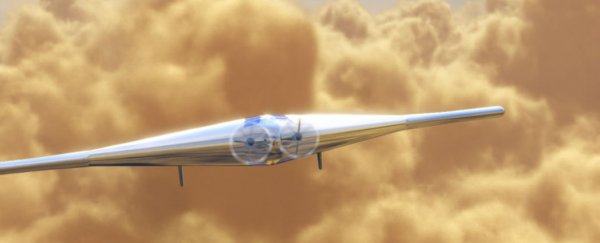An inflatable, propeller-powered aircraft, built from lightweight composites, could be a candidate to explore the dense, sulphur-rich skies around Venus on a multi-year mission.
US-based aerospace and defence firm, Northrop Grumman, is developing the concept craft, and plans to enter NASA's fourth New Frontiers planetary science competition, which will begin accepting submissions from international teams in October.
The New Frontiers program began in 2002 and helps fund medium-sized missions to explore our Solar System. In 2006, New Horizons was launched on a journey to Pluto; five years later, the Juno spacecraft departed for Jupiter, and sometime next year, OSIRIS-REx will embark on a mission to collect samples from an asteroid.
While the fourth New Frontiers program has not been announced, one possible mission would send probes to Venus to study the chemical composition and physics of the planet's heavy atmosphere and crust. This would require a craft that could reach its lower atmosphere.
Northrop Grumman believes its concept spacecraft - the Venus Atmospheric Maneuverable Platform, or VAMP - would be able to fly 50 km above the planet's surface in order to get the job done. And the firm expects to be in a position to compete for the roughly $1 billion in NASA funding that's up for grabs. "I think we can be ready," Ron Polidan, chief architect of civil systems at Northrop Grumman, told Dan Leone at SpaceNews.
If it were selected, the craft would need to be ready for an anticipated launch date in 2021. But there are massive hurdles to overcome in the interim.
As Leone points out for SpaceNews:
"Neither VAMP nor anything like it has ever flown. The closest thing there is to a VAMP prototype today is a pair of ultra-light wings built in 2008 and 2010 by Northrop's partner L.Garde Inc. of Tustin, California, for a defunct Defense Advanced Research Projects Agency initiative called Rapid Eye."
The larger of the wings was only 2-metres-long, and was only ever tested in wind tunnels - never in flight. Polidan says an operational VAMP aircraft would need to have a wingspan close to 55 metres in length.
He estimates that the concept is currently at a technology readiness level of 3, and this would need to progress to at least level 6 by the preliminary design review stage. This would give the firm around four years to deliver a prototype, and prove that VAMP can fly autonomously at mission-ready weight, carrying and powering all the required scientific instruments, Leone writes.
Venus is a hostile place. It's surface temperature hovers around 460 degrees Celsius, and the pressure on the ground is about 90 Earth atmospheres - about what you'd expect 900 metres underwater. It makes sending rovers to the planet difficult.
An aircraft that can cruise at an altitude between 50 and 70 km, by comparison, would be operating in more agreeable conditions, with atmospheric pressure similar to that experienced at sea level on Earth, and temperatures at a friendlier 15 degrees Celsius. "Not a whole lot different than flying on Earth," Polidan told SpaceNews.
Come October, Northrop's VAMP craft will inevitably meet some stiff competition from contenders developing probes bound for Saturn, and Jupiter's moon Io. There will likely be some other candidates for the Venus mission, as well, possibly looking to reach the surface.
Regardless of what happens, I think we can all agree that competitions like this are pretty awesome, as they not only push the boundaries of what's possible for space exploration, they also fuel our imaginations.
